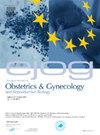A multicenter cohort study analysing the implementation of a new guideline for women with pregnancy of unknown location or ectopic pregnancy in the Netherlands
IF 2.1
4区 医学
Q2 OBSTETRICS & GYNECOLOGY
European journal of obstetrics, gynecology, and reproductive biology
Pub Date : 2024-11-09
DOI:10.1016/j.ejogrb.2024.10.058
引用次数: 0
Abstract
Objective
Evaluation of the implementation of a new guideline for diagnosis and treatment of women with pregnancy of unknown location (PUL) or ectopic pregnancy (EP).
Design
Multicenter retrospective cohort study.
Setting
Six hospitals in the Northern part of the Netherlands.
Population and methods
Women above 18-years old with a final diagnosis of PUL or EP between January 2012 to April 2020.
Main outcome measures
Diagnostic findings, type of treatment and outcomes, before and after implementation of the guideline. User interpretation of the guidelines.
Results
1306 women with PUL (N = 289) or EP (N = 1017) were included. The amount of women diagnosed with PUL has significantly (P < 0.001) increased between the previous guideline (16.6 %; 115/693) and the new guideline (28.4 %;174/693). A significantly lower percentage of women, after implementation of the new guideline, underwent surgical management (odds ratio [OR] = 0.516, 95 % confidence interval [CI] 0.399 – 0.668P < 0.001) versus treatment with MTX (odds ratio [OR] = 2.529, 95 % confidence interval [CI] 1.719 – 3.723, P < 0.001). The overall success of treatment with MTX was 80.5 % (N = 103) compared to 95.2 % (N = 907) of surgery (P < 0.007). There was no observed difference in adverse events or guideline adherence between the guidelines.
Conclusion
The implementation of the new guideline contributes to an increase in women diagnosed with PUL and treated with MTX. Treatment with MTX caused more complications and a lower treatment success compared to women undergoing surgery. This did not lead to an increase in adverse events between the guidelines. The overall adherence to the guidelines was equal.
Key message
Implementation of the new guideline contributes to an increase in women diagnosed with PUL and conservative treatment with methotrexate (a drug with a higher risk of complications and a lower successful treatment compared to surgery), however this did not lead to an increase in adverse events between the old and new guideline.
一项多中心队列研究,分析荷兰针对妊娠位置不明或宫外孕妇女的新指南的实施情况。
目的评估位置不明妊娠(PUL)或异位妊娠(EP)妇女诊断和治疗新指南的实施情况:多中心回顾性队列研究:研究地点:荷兰北部地区的六家医院:2012年1月至2020年4月期间最终诊断为不明原因妊娠(PUL)或异位妊娠(EP)的18岁以上女性:主要结果测量:指南实施前后的诊断结果、治疗类型和结果。用户对指南的解释:共纳入 1306 名患有 PUL(N = 289)或 EP(N = 1017)的女性。被诊断为 PUL 的女性人数明显增加(P新指南的实施增加了被诊断为 PUL 并接受 MTX 治疗的妇女人数。与接受手术治疗的女性相比,MTX 治疗引起的并发症更多,治疗成功率更低。这并没有导致指南间不良事件的增加。对指南的总体遵守情况相同:关键信息:新指南的实施增加了确诊为PUL并接受甲氨蝶呤保守治疗的妇女人数(与手术相比,甲氨蝶呤是一种并发症风险较高且治疗成功率较低的药物),但这并没有导致新旧指南之间不良事件的增加。
本文章由计算机程序翻译,如有差异,请以英文原文为准。
求助全文
约1分钟内获得全文
求助全文
来源期刊
CiteScore
4.60
自引率
3.80%
发文量
898
审稿时长
8.3 weeks
期刊介绍:
The European Journal of Obstetrics & Gynecology and Reproductive Biology is the leading general clinical journal covering the continent. It publishes peer reviewed original research articles, as well as a wide range of news, book reviews, biographical, historical and educational articles and a lively correspondence section. Fields covered include obstetrics, prenatal diagnosis, maternal-fetal medicine, perinatology, general gynecology, gynecologic oncology, uro-gynecology, reproductive medicine, infertility, reproductive endocrinology, sexual medicine and reproductive ethics. The European Journal of Obstetrics & Gynecology and Reproductive Biology provides a forum for scientific and clinical professional communication in obstetrics and gynecology throughout Europe and the world.

 求助内容:
求助内容: 应助结果提醒方式:
应助结果提醒方式:


